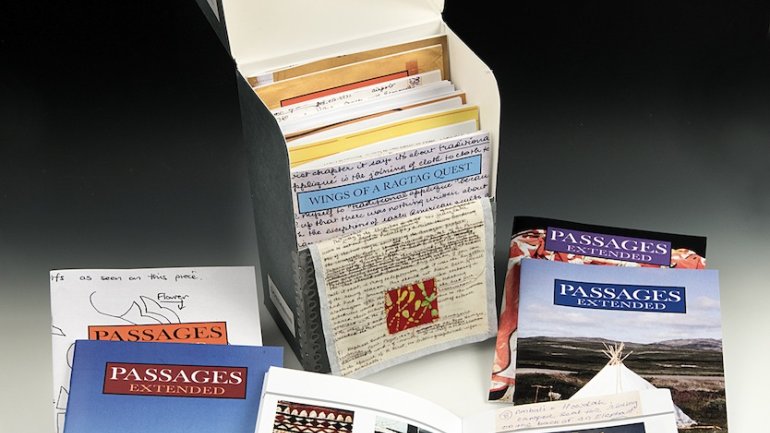What We're Reading Now: Wings of a Ragtag Quest
The ACC Library recently acquired Wings of a Ragtag Quest, a very special artist's book by beloved fiber artist and art professor, Nell Battle Booker Sonnemann. Wings was compiled and edited by Patricia Malarcher, friend, fellow textile artist, and custodian of Sonnemann's papers (the artist passed away in 2004). The book traces Sonnemann's late-in-life expedition around the globe in search of traditional fiber appliqué techniques.
In 12 lovingly assembled volumes, Sonnemann's journey is documented through illuminating handwritten field notes, maps, and photographs she and her colleagues collected while visiting places like the Canadian Arctic, Syria, the Peruvian Amazon, India, Bhutan, and Bangladesh, to name a few.
Wanting to know more about Sonnemann's idiosyncratic life and travels, we caught up with Malarcher, who shared these insights on the project.
What is the meaning behind the title Wings of a Ragtag Quest?
Nell liked playing with words. One definition of “quest” is “an adventurous expedition undertaken by a knight or knights to secure or achieve something.” I think that describes her somewhat quixotic view of her commitment to record knowledge of “a dying art form.” “Ragtag” could refer both to the material substance of appliqué and to the disconnected medley of writings that comprised the book. I can only guess about “Wings,” but for me it suggests a lightness, a letting go of predetermined purposes, allowing what the book became to fly on its own.
What were some of the most surprising discoveries you made while sorting through Sonnemann’s notes and unpublished writings?
Although Nell relied heavily on serendipity when she was actually traveling, her files revealed that she did extensive research in preparation for her trips – e.g., correspondence with academics and cultural ministries, exhibition catalogs, and books documenting specific textile traditions, travel brochures, and a voluminous bibliography of sources.
She also had meticulous notes on where she had been and on each of hundreds of slides, the source and description were recorded.
Sonnemann began traveling when she was in her 50s, visiting over 20 countries on four continents. When her health failed she sent friends and colleagues, yourself included, to places like Mongolia, Bangladesh, and Bhutan to continue her work documenting folk appliqué. What universal findings about traditional appliqué techniques were discovered in these various travels?
More than technical information, what we came to appreciate collectively was the notion of appliqué as a metaphor for what we experienced—for example, reliance on random discoveries to fulfill our missions.
I can’t speak of universal findings regarding appliqué techniques, but many of us found that specific types of appliqué were valued for their cultural meaning by the communities that produced them.
Also worth noting, perhaps, is that somehow all of us “co-questors” gladly participated even with little knowledge of what we might encounter. Nell sent us off without specific instructions, but encouraged us to not just to extend her quest but to find our own.
Why take Sonnemann’s notes and publish them as a limited edition set of 12 travel journals, rather than a scholarly text? Can you talk a little about the process of designing this unique artist’s book?
Although Nell’s original intention was a scholarly book, what she produced was a series of diverse narratives supplemented by accounts her “co-questors” wrote about their experiences. These varied from Joyce Koskenmaki’s poetic response to nature and artifacts in Lapland to Jill Loveland’s detailed report on appliqué in Bangladesh. Nell had said that she wanted Wings of a Ragtag Quest to be published “with all the loose ends and frayed edges.” I took that as a mandate to deal with what was actually there rather than forcibly constrict it into a more conventional format.
The design of the book was prompted by the contents. Sarah Bodine, the designer, and I agreed that the self-sufficient character of each component called for a set of individual books. The personal nature of the texts suggested a size that was comfortably held in the hand. In order to convey the spirit of the quest, Sarah designed a layout that could include snippets from letters and manuscripts, receipts from purchases, hand-drawn maps, and other trivia, as well as on-site photographs.
The archival box designed for library storage of pamphlets was the right size and shape, but its impersonal exterior seemed to need the fabric “apron”— a cloth imprinted with Nell’s handwriting from an early draft – to suggest what was within.
Although the book is more reflective of Nell as an artist assembling works from scraps of fabric than as a dedicated researcher, her inner scholar came through in her thorough documentation of more than 500 appliquéd garments, household accessories, animal regalia, and more that comprise the Nell Battle Booker Sonnemann Collection at the Gregg Museum, North Carolina State University in Raleigh.
What do you hope readers take away from exploring Wings of a Ragtag Quest?
I hope they might appreciate Nell as a person driven by a vision, persisting in spite of knowing that illness and other obstacles were inevitable. I hope the book conveys the joy of the quest as a value in itself, even though it fulfilled a mission in a different way than originally conceived.

